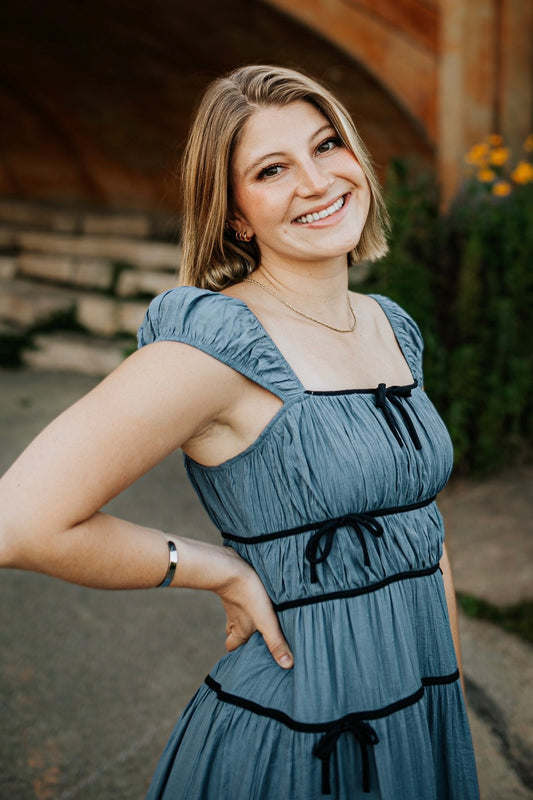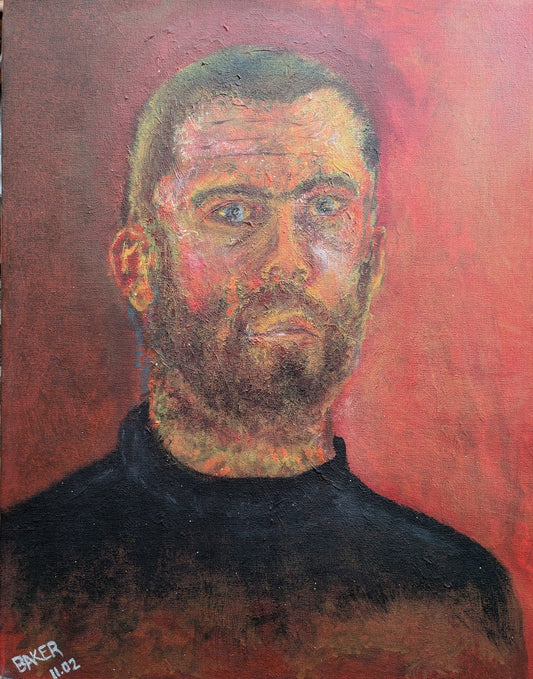Tyler Voorhees, a multidisciplinary, Michigan-based artist with an insatiable thirst for wanderlust, hopes to connect people through images of the past. His long-running painting series, The Jobs of Yesteryear, highlights unique occupations of antiquity and the hard-working laborers who undertook them.
ArtRKL recently sat down with Tyler Voorhees for an interview, discussing his extensive Jobs of Yesteryear series, how he developed his distinct whimsical style, what traveling means to him, and what he has in store for the year ahead in 2024.
Background
Growing up in South Dakota, Tyler Voorhees was “blessed with a childhood full of tree forts and fishing poles.” Throughout his childhood, he had always loved to create, but drawing was his “first love.”
But when it came time for college, Voorhees didn’t study art. At least not at first.
“I actually initially went into architecture,” Voorhees explained. Like many artists, Voorhees was “met with the practicalities” of making art as his career. Many suggested that Voorhees pursue art as a hobby on the side but advised him to find a more lucrative job that would allow him to do what he loved. So, he landed on architecture.

“I like math. I'm good at math as well as science. And I thought, ‘Oh, it’s like geometry that people live in. I get to draw and do this cool drafting practice that I enjoy doing.’ Then I actually went and job-shadowed an architect for a day. And he was one of the most miserable people I've ever met.”
Spending the day watching the architect draw using a computer mouse, Voorhees saw that the man was “bored and had no passion.” Voorhees was grateful to see the realities of the job and knew that he had to pivot his career to what he truly enjoyed doing. After all, he didn’t like math that much.
Voorhees eventually found his way to the Black Hills State University art program in Spearfish, South Dakota. He immediately connected with everyone in his cohort and found his crowd there. He graduated with his BFA in art in 2006.
What followed was a series of “little miracles” that allowed Voorhees to create the life he has today as a full-time artist. Those little miracles just weren’t a stroke of luck, Voorhees clarifies. “But it's pretty incredible the way things lined up.”
The Jobs of Yesteryear Series
Voorhees's Jobs of Yesteryear series is his main project. Each work "combines history and surrealism to tell the stories of obsolete jobs" by depicting the workers amidst their craft, employing Voorhees's signature use of exaggerated proportions and a monochromatic color palette.
The idea for The Jobs of Yesteryear came about when Voorhees realized he needed a consistent body of work to get into galleries and festivals. Before the series' inception in 2011, he was taking any commission he could get to learn something new from each one.
The long-limbed, lanky character that's now synonymous with Voorhees's art is what The Jobs of Yesteryear series was initially designed around.
“I had been drawing this really long-limbed character for a long time. I just love it. It's just fun and makes me smile. I've spent a lifetime trying to figure out why I love that particular style, but I just do,” Voorhees explained.

“I'd been drawing that and trying to think of what kind of a series I could create with this character. At the same time, I was looking through some old photographs because I just love history. I found a photograph of a lamplighter bicycle. And so, you know, a lamplighter, what is that? That was a job.”
Lamplighters were those tasked with maintaining the public oil and gas streetlights of the 16th century. At dusk, the lamplighter would light the lamp with a wick affixed to a long pole. Sometimes, the lamplighter would use a tall bike to reach the lamp instead of a ladder. Due to the invention of incandescent lighting, lamp lighting as a job has become entirely obsolete.
Voorhees noticed that the lamplighters’ tall bikes of old fit his long-limbed character perfectly, and he set out to create what would become the first painting in The Jobs of Yesteryear series.
After finally finishing the first iteration of The Lamplighter, Voorhees showed the painting to his wife, who encouraged him to create more pieces in that style.
“[My wife]'s always been a great critic. She's not just gonna tell me it's great if she doesn't feel that way. So I know if she likes it, she really does like it.”
From there, Voorhees developed a newfound confidence in his concept. He began exploring other “old jobs” beyond lamplighters, and soon found there was a wealth of history he could connect with through The Jobs of Yesteryear series.
“I've been doing the series in earnest as my full-time job for about eight years. And that's when the bulk of the paintings have happened, and that's when all the progress has really shown. I'm almost at 300 paintings in the series.”

Although the series started by depicting strictly obsolete jobs and nonexistent jobs, Voorhees clarifies that the series has evolved to include jobs that are not necessarily obsolete but have drastically changed their forms, thanks to technological advances.
Voorhees also ensures that he includes a small detail within the painting that signifies how the job has changed or been made obsolete. For example, in The Iceman IV, an ice machine can be seen in the background. In each iteration of The Lamplighter, Voorhees will hide some representation of electricity to show how the occupation of the lamplighter eventually was overtaken by this innovation.
“It's often hidden and not always easy to find, but including this bit of history allows me to tell more of the story of the job as it exists over time and also more readily connects the story to the present.”
No matter the job, Voorhees's process for creating a new piece in The Jobs of Yesteryear series always begins with research. Sometimes, Voorhees will be inspired by old jobs mentioned in both fiction and non-fiction books, giving him some initial background on the job. He'll spend around one to two hours reading everything available about the job and looking at reference photos.
“My more recent work has actually stayed closer to reference photographs, which I've realized is a way to add more realistic life to my paintings, which has been really a nice new direction to take the painting.”
After the initial research phase is done, the past comes alive as Voorhees begins drawing, painting, and collaging.
Mixed media and style
Voorhees's website notes that the works of The Jobs of Yesteryear series "have the feel of a tattered black and white photograph steeped in history." This is thanks to Voorhees's expert use of mixed media. On top of watercolor paper, he uses craft paper to create collage pieces that make up his long-limbed characters. Then, he coats the piece in acrylic wash.
Voorhees is drawn to incorporating mixed media in his work for several reasons.


"There's a physicality to it. I paint the background, and I build this character, you know, I cut paper, and it's this thing that I can hold and play around with. I also draw them out first, I get to do more of that drawing I enjoy. Initially, I was just trying to find a way to play with the viewer's focus and to make the worker part of the background and part of the composition, but stand out in a way,” he explained.
The finer details of each piece's collaged bits also intrigue the viewer to look closer.
“I really like subtleties. I like a little bit of mystery and a sense of discovery as a viewer. And so the collage is a way to draw the viewer in.”
Another reason why Voorhees is so drawn to exploring dimension and depth in The Jobs of Yesteryear series is due to how he sees the world—literally.
When he was three years old, Voorhees ran into a tree, leaving him “mostly blind” in one eye.
“I grew up without developing depth perception,” he recounted. “I think about that a lot, you know, everything in my world is kind of relegated to flat surfaces.” Voorhees sees his paintings as working layers that build up dimension as they go. “The collage is just a more robust way to achieve that at the end.”
The other prominent element of Voorhees's works is, of course, the larger-than-life characters who have become part of Voorhees's artistic identity. While they differ in attire depending on the piece, all of the workers in Jobs of Yesteryear are incredibly tall with spindly limbs. You're not alone if they remind you of something out of Tim Burton's The Nightmare Before Christmas or the internet horror character Slenderman, you're not alone.
“Some people find it creepy, and I'm not saying that's wrong. That's just an interesting reaction,” Voorhees commented.

He asserts that his characters come from a place of whimsy and fun, and aren’t intended to be unnerving, but he can understand how his characters bring out the “macabre fascination” in viewers.
The actual influences Voorhees took from when designing his characters are steeped in surrealism and nostalgic caricature art. Like many artists in their early, formative days, Voorhees recalls that he tried his hardest to replicate his subjects as realistically as possible. He felt that being able to draw something exactly as you see it was the mark of a true artist.
“I remember the moment I realized that wasn't necessarily true [was] when I saw those ‘giant head’ caricature artists. I think it was someone at Seaworld or something, but I had my portrait drawn, and it was me kicking a soccer ball. [The ball] was bonking off my head, and I loved it. I thought it was so fun, and it just opened my eyes. Like, oh, ‘What else can I play with?’”
Voorhees's love for extended, fantastical proportions also came from surrealist artists like Salvador Dali.
“I wrote a whole blog about getting this book of [Salvador Dali art] from my uncle for Christmas one year. I still have the book. The Temptation of St. Anthony is on the cover. There’s a really tall giraffe and a tall elephant, a parade of animals coming towards this man in the desert.”
Looking at the 1946 painting by the Spanish artist, it's easy to see Dali's influence on Voorhees's art.
“It still takes my breath away. I just love that painting.”
Although the characters are the focal point of each piece of The Jobs of Yesteryear series, perhaps its most crucial element is what the series has to say about the history (and future) of working.
Connecting through work
Why the focus on work and labor? Because it matters, Voorhees says.
“The overarching theme [of the series] is these workers matter, enough for me to paint them and want to study them. But your work matters too, even though most days it feels like it doesn't. Because everyone has those days.”
Voorhees wants The Jobs of Yesteryear series to help people connect to the past and encourage them to think about their own lives through a historical lens.
“I think that the jobs and occupations of the past [are] a way to dig deeper and connect more powerfully to people of the past with the intent of also connecting to people in the present through that,” Voorhees told ArtRKL. “Because people look at the paintings and they think, ‘Oh, this is a cool job.’ And then inevitably, ‘Well, what's my job? How is my job different from that? How am I different from that?’”
He says that traveling has been a way for Voorhees to deepen that connection to others and inspire his art.
Traveling and Making A Living As An Artist
While his love for history is one of the things that drives his work, Tyler Voorhees might have an even bigger love for travel.
“Traveling has become this way to breathe in experiences. I've got this crazy wanderlust. Luckily, my wife does, too. Hers might be even stronger than mine. We just live for experiencing new places.”


Voorhees lived in Germany for almost two years shortly after college with his future wife, Ashley. Then, in 2015, after starting his family and committing to art full-time, Voorhees and his wife took their son on the road and traveled for nearly nine months and 17,000 miles across the country, visiting art festivals along the way. Now a family of four, the VoorheesesVoorhees have since settled in Southwest Michigan, but their love for travel remains. Having been to countries like Spain, Germany, and Morocco, Voorhees says that the sense of discovery that comes with travel is what inspires him to create.
For young artists looking to make a living off of their art, Voorhees advises having some economic knowledge (or knowing someone who does) to help understand the business aspects of having a full-time art career. Voorhees credits his wife as the one who keeps things afloat financially.
“She's really the reason we do this for a living. She has a business mind, this sense of how to practically do it and how to make a business out of art. I'm always reminded of the importance of that.”
What’s Next
After his website’s annual holiday sale, in 2024, Voorhees plans to keep things loose in the studio.
"I'm always trying to be less analytical and just more free-flowing," he said. "That's' my aim for every year I approach the new year in the studio. Stay loose, be open to new ideas, and enjoy the process."
He will create more paintings for The Jobs of Yesteryear series, of course, but Voorhees always strives to elevate his work to make things “a little more surprising.” Although nothing is set in stone, Voorhees will likely travel to an art festival or two, where he’ll connect with new faces and new places.
If you see him, say hi. Or better yet, tell him about your day at work.
To connect with Tyler Voorhees, see what he’s working on, and where he’ll be next, visit his website, follow him on Instagram, or support him on Patreon.
©ArtRKL™️ LLC 2021-2024. All rights reserved. This material may not be published, broadcast, rewritten or redistributed. ArtRKL™️ and its underscore design indicate trademarks of ArtRKL™️ LLC and its subsidiaries.





